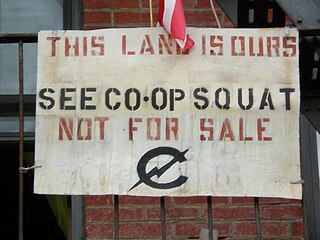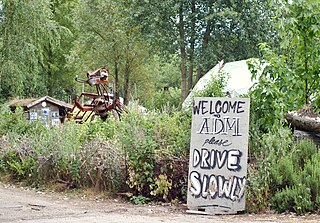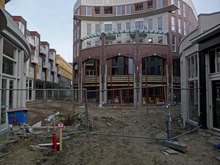
Squatting is the action of occupying an abandoned or unoccupied area of land or a building, usually residential that the squatter does not own, rent or otherwise have lawful permission to use. The United Nations estimated in 2003 that there were one billion slum residents and squatters globally. Squatting occurs worldwide and tends to occur when people find empty buildings or land to occupy for housing. It has a long history, broken down by country below.

De Blauwe Aanslag was a squat and self-managed social centre in the Dutch city of The Hague. The oldest part of the building was built in 1886. The large building formerly housed tax offices and was occupied in 1980. When the local council took over the ownership of the building, it was agreed to renovate it in three stages, with the squatters living there. However the plans changed and since 1995 the council decided to widen the roads next to the building; for this reason the squat needed to be demolished. After many efforts to block the demolition with lawsuits, the squatters were evicted by military police on 3 October 2003.
Eurodusnie Collective was an anarchist collective based in Leiden, the Netherlands. It was established in 1997, in opposition to a summit of the European Council at which the Treaty of Amsterdam was signed. A small school was squatted for the purpose of holding a 'counter summit' as a protest over the official EU summit. From that, a more permanent anarchist project evolved which was of national importance.

C-Squat is a former squat house located at 155 Avenue C in the Alphabet City neighborhood of Manhattan, New York City that has been home to musicians, artists, and activists, among others. After a fire, it was taken into city ownership in 1978 and squatters moved in 1989. The building was restored in 2002 and since then it has been legally owned by the occupants. Its ground-floor storefront now houses the Museum of Reclaimed Urban Space.

Self-managed social centres in Italy exist in many cities. They are part of different left-wing political networks including anarchist, communist, socialist, and autonomist. The centres tend to be squatted and provide self-organised, self-financing spaces for alternative and noncommercial activities such as concerts, exhibitions, farmers' markets, infoshops, and migrant initiatives. Over time, some but not all projects have opted to legalize their status.
The Dutch squatting ban refers to the law introduced on 1 October 2010, under which squatting in the Netherlands became de jure illegal. Criminalization had first been proposed in the 1970s, but was opposed by the Council of Churches. In 2006, a new plan was proposed and backed by parties including VVD and PVV. When the new law was introduced, squatters occupied the former head office of the fire brigade and there were riots in Amsterdam and Nijmegen. In 2011, the Supreme Court of the Netherlands ruled that the legally forced end of squatting can only occur after an intervention of a judge. Between October 2010 and December 2014, 529 people were arrested for the act of occupying derelict buildings, in 213 separate incidents as a result of which 39 people were jailed.

In England and Wales, squatting – taking possession of land or an empty house the squatter does not own – is a criminal or civil offence, depending on circumstances. People squat for a variety of reasons which include needing a home, protest, poverty, and recreation. Many squats are residential; some are also opened as social centres. Land may be occupied by New Age travellers or treesitters.
In the United States, squatting occurs when a person enters land that does not belong to them without lawful permission and proceeds to act in the manner of an owner. Historically, squatting occurred during the settlement of the Midwest when colonial European settlers established land rights and during the California Gold Rush. There was squatting during the Great Depression in Hoovervilles and also during World War II. Shanty towns returned to the US after the Great Recession (2007–2009) and in the 2010s, there were increasing numbers of people occupying foreclosed homes using fraudulent documents. In some cases, a squatter may be able to obtain ownership of property through adverse possession.

ADM was a squat in the Port of Amsterdam, to the west of the city next to the North Sea Canal. The squat lasted from 1997 until its eviction in early 2019. Around 130 people lived on the terrain of 45 hectares in buildings, on boats and in vehicles.

Vrijplaats Koppenhinksteeg was a complex of buildings first squatted in 1968 in Leiden, the Netherlands. It took its name from the alley on which it was located and was run since the 1990s by the Vrijplaats Koppenhinksteeg Foundation. Various groups including Eurodusnie used the different spaces as a bar, café, a freeshop, a foundation to support undocumented migrants, an information centre, a library and a sports club. In 2010, the entire complex was evicted. From 2012 onwards a new space called the Vrijplaats Leiden was set up elsewhere.

Squatting in the Republic of Ireland is the occupation of unused land or derelict buildings without the permission of the owner. In the 1960s, the Dublin Housing Action Committee highlighted the housing crisis by squatting buildings. From the 1990s onwards there have been occasional political squats in Cork and Dublin such as Grangegorman, the Barricade Inn, the Bolt Hostel, Connolly Barracks, That Social Centre and James Connolly House.

We Are Here is a collective of migrants based in Amsterdam, the Netherlands, which campaigns for human rights for its members and all undocumented migrants. The asylum seekers have in many cases had their applications to remain in the Netherlands denied but they either cannot go back or refuse to return to their country of origin. They demand access to social services such as medical care and housing. The group formed in 2012 and by 2015 contained over 200 migrants from around 15 countries.

Vrankrijk is a legalised squat and self-managed social centre on the Spuistraat in central Amsterdam. There is an events space on the ground floor and above it a separate housing group.

Squatting in the Netherlands is the occupation of unused or derelict buildings or land without the permission of the owner. The modern squatters movement began in the 1960s in the Netherlands. By the 1980s, it had become a powerful anarchist social movement which regularly came into conflict with the state, particularly in Amsterdam with the Vondelstraat and coronation riots.

The Tabakspanden are a group of buildings standing on the Spuistraat in central Amsterdam, adjacent to the Keizerrijk and Wijdesteeg alleyways. Named after a former owner, the speculator Hendrik Tabak, they were mostly squatted from 1983 onwards, although the artist Peter Klashorst also rented an apartment and gallery space. The best known building was Spuistraat 199, known as the Slangenpand (Snakehouse) because of the large mural which covered the front exterior. In 2015, the squatters were evicted and the buildings were mostly demolished prior to redevelopment. The new project is known as De Keizer and has 69 apartments, a restaurant and a gallery. Two of the buildings are registered as rijksmonumenten.

De Vloek was a squatted, self-managed social centre in The Hague, the Netherlands, between 2002 and 2015. Located on Hellingweg 127 in Scheveningen, beside the North Sea, the squat hosted workplaces, living spaces, a venue, and a vegan restaurant. The local council tolerated the occupation until 2014, when it decided to sell the building. A political struggle over the eviction began; some political parties supported the squatters and the Scheveningen Pier was briefly occupied as a protest action. A deal was made for the squatters to move to a former school building and the Vloek was eventually evicted in September 2015.

Squatting became a political phenomenon in the Czech Republic after the Velvet Revolution in 1989. Squats in Prague included Sochora, Stary Střešovice and Ladronka. Milada was occupied in 1998 and following its final eviction in 2009, there was a lull in squatting actions. In the 2010s a new social movement squatted houses to highlight the number of derelict properties in Prague and the social centre Klinika was founded in 2014.
Squatting in Slovenia is the occupation of derelict buildings or unused land without the permission of the owner. Housing was illegally built from the 1960s onwards and informal settlements have been set up by Romani people or poor immigrants. In the capital Ljubljana, there is the autonomous zone of Metelkova and the Rog self-managed social centre was evicted in early 2021.
The modern political squatting movement began in Hamburg, Germany, when Neue Große Bergstraße 226 was occupied in 1970. Squatters wanted to provide housing for themselves amongst other demands such as preventing buildings from being demolished and finding space for cultural activities. The Hafenstraße buildings were first occupied in 1981 and were finally legalized after a long political struggle in 1995. The still extant Rote Flora self-managed social centre was occupied in 1989. Squatting actions continue into the present; more recent attempts are quickly evicted, although the Gängeviertel buildings were squatted and legalized in the 2010s.

The Wyers squat was a self-managed social centre on Nieuwezijds Voorburgwal in central Amsterdam, the Netherlands, between 1981 and 1984. The buildings of the Wyers former wholesale textile company were converted by the squatters into a range of living and work spaces. When the Government of Amsterdam decided to demolish the complex to make way for a Holiday Inn hotel, a car parking garage and apartments, the squatters made alternative proposals. The eviction was announced for February 14, 1984, and there were demonstrations in support of the squat around the country. On the day of eviction, 1,500 people stayed inside the building then left without conflict. The breeding place discourse of new cultural initiatives presented by the squatters was later adopted by the city council.
















